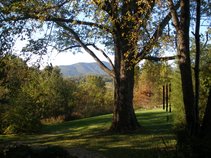
Twenty hours in the air and a half-planet away from home, Mongolia's Ulaanbaatar finally reveals itself in a treeless valley surrounded by the four sacred peaks of Bogd Khan, Bayanzurkh, Chingeltei, and Songino Khairkhan. It's 10 p.m. when we land, yet only sunset in this northern latitude. Burnt orange light streaks the ground between long shadows. The darkening sky and the treeless plain squeeze between them the last minutes of day. On the horizon, an iridescent thunderstorm pours torrential rain down its mushroom stalk. Soviet-era helicopters sit in the weeds and rust under sagging rotors.
My brother Grant and I have come to this historically Buddhist land to see the state of the dharma ten years after the end of Soviet rule. For centuries, the country has had strong ties to Tibetan Buddhism—indeed, before the Soviet "repression time" beginning in 1921 some estimates counted more than 98% of the population as Buddhist though recent studies suggest that has dropped significantly.
At baggage claim, we see why: a battalion of well-groomed Mormon missionaries wearing black suits and gold name tags. They are cheery, polite, relentless. We soon learn that they are the dharma's main competition for the hearts and minds of Mongolians. More troops to the front lines.
Before heading into the country, we spend two days here. Almost half the country's population of Mongolia crowds into this capital city of one million. Deep potholes and broken streetlights reveal the surface state of a crumbling infrastructure. Broad avenues teem with a human succotash of ancient style and urban culture. Young girls queue up for water at public pumps. One-horse wagons dodge buses and cars that careen wildly in no-rules driving. Young toughs in L.A. Dodgers caps play pool on tables sitting out in the open air. Exhaust fumes, dust, and cook smoke hang in the air. Animal bones litter the ground, some still clinging to remnants of flesh and fur. Dirt streets meander throughout, bordered by ramshackle fences that shield from random theft the family gers, the traditional round tent of the Mongols.
During their rule, the Russians imposed a command economy on a nomadic people. When they left, the economy sputtered to a halt. The Russians had also destroyed 700 monasteries, forced thousands into slave labor, and slaughtered 17,000 monks and 10,000 citizens. Many lie buried in mass graves with bullet holes in the backs of their heads. The Russians forced the surviving monks to abandon Buddhism, marry, and enter secular life. Even so, many continued to practice in secret while hiding sacred objects for a time when the dharma could reemerge.
That time came in 1991, when a peaceful revolution led to a democratic government. The Mongolian dharma emerged from seven decades of subjugation severely weakened. Christian missionaries—particularly Mormons—have swarmed into the spiritual vacuum seeking converts while the consumerist din of Mongolia's emerging Western-style market economy threatens to drown out the quieter clarity of the dharma.
But the dharma is adapting. Prime Minister Enkhbayar is a practicing Buddhist (and, yes, a Communist in a democratic republic) who is keenly interested in preserving Mongolia's Buddhist heritage. Many provincial governors and members of parliament share his passion. We visited Gandan monastery in Ulaanbaatar, Erdene Zuu and Shankh Khiid monasteries in the ancient capital Kharkhorin, a temple in Dalanzadgad, and talked to abbots, lamas, and monks. Speaking to us in their rhythmic, whispering language with soft, glottal inflections, they showed us their reconstruction efforts and where they restored to their spiritual place the relics and statuary their predecessors hid during the Soviet era.
Out in the country, the endless blue sky and undulating hills exude a primeval magic almost unbearably moving. In a jeep, it's unbearably moving, too, as in teeth-chattering, organ-jarring, head-banging bumpy. Mongolian "roads," well, aren't.
In Kharkhorin we drink airag, fermented mare's milk that tastes like salty cream and quinine water. Nice buzz. From Dalanzadgad, we drive through the minimalist majesty of the Gobi, dodging sand devils and camel carcasses while skimming over the trackless plain like speed boats. A white vulture soars above us in a Yol Valley canyon. I slip on an ice flow in the summer heat of the desert. The Flaming Cliffs lick the horizon at sunset. And later that night under glimmering starlight at Three Camels Lodge, traditional singers Nara and Eata sing a Praise to Altai Mountain. And all the while we eat dried mutton, and mutton patties, and boiled mutton, and mutton meat sauce, and mutton soup, and never wonder why we don't see any sheep. We've eaten them all.
The Mongolian dharma, frail as it may appear now, seems poised to transcend this moment in history. I see it comfort an old woman turning a prayer wheel and sustain the monks rebuilding their cherished sites. I feel it riding the Gobi wind and steeped in the very rock strata of these old mountains. Certainly, the men in black and the clangorous western marketers will paint their colors here and there, but their brushes cannot take them deep to where the dharma lives.

